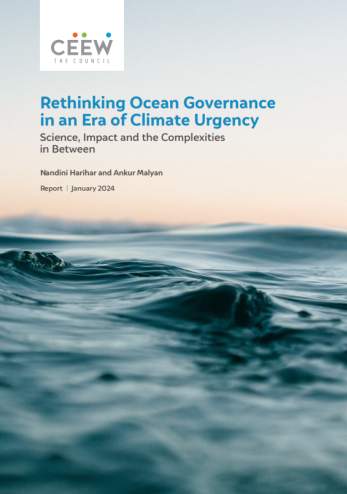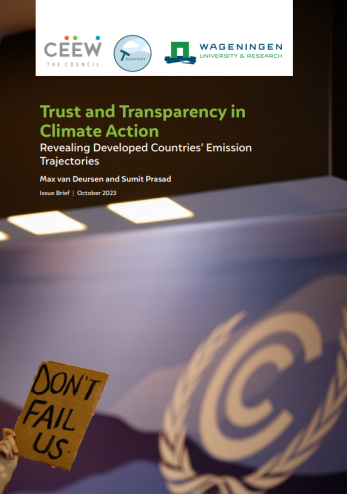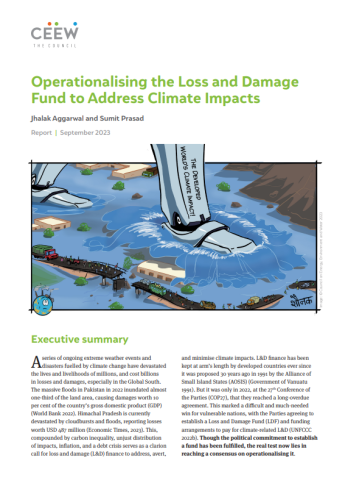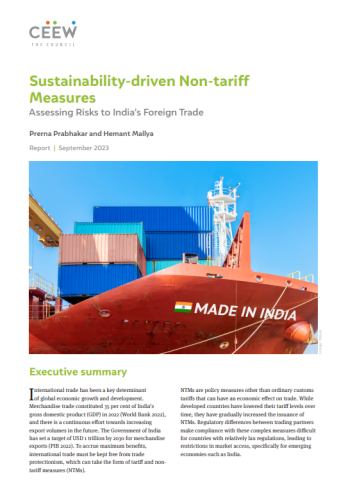



Suggested Citation: Aggarwal, Jhalak, Shikha Bhasin and Sumit Prasad. 2022. Communicating Climate Action Effectively: A Reporting Framework for Nations to Inform the Public. New Delhi: Council on Energy, Environment and Water.
The issue brief discusses the importance of communicating climate information to the larger public and enhance their understanding of countries' climate performance. We propose a common, broad set of indicators on key elements that can provide an overarching view of the overall climate actions of different nations so that the general audience can understand better. The idea is premised on the fact that communicating technical climate information is necessary for good science communication and effective public engagement.
The enhanced transparency framework (ETF), formulated as part of the Paris Agreement at the 26th Conference of Parties (COP26), lays down the rules for all Parties to the Paris Agreement to regularly communicate, share, and review their climate efforts. The agreed guidelines demand reporting of extensive granular information and deeper analysis into different aspects, which necessitate specialist knowledge for understanding the presented data.
While it is essential to enhance transparency, it is also important to communicate climate-related information to the larger public so as to enhance their understanding and engagement in climate actions. As the impact of climate change becomes evident, it is crucial to close the gap between knowledge and action amongst the public, thus stating the imperative need to communicate countries’ climate actions in a simple, concise, and easy-to-understand manner.
With this in mind, we suggests that countries report on the proposed indicators in the executive summary of the biennial transparency report under ETF. This would facilitate increasing the public understanding of the nation’s climate progress. It allows the audience to ask an essential question: to what extent, if at all, is the nation performing and contributing to far-reaching climate action?
To determine the proposed indicators, our analysis involved an extensive literature review to understand the key factors that define a nation’s climate performance as well as indicate their progress across various aspects of climate action. The indicators are chosen based on their relatively high importance in measuring the countries’ overall efforts in global climate actions and consistency with the current level of available information to calculate the data points.
We state that these indicators would allow benchmarking of countries’ performance, will not place additional burden on nations’, and could provide a snapshot of a country’s effort. And we conclude by stressing that the disclosure on these indicators will lead to accountability, trust, and enhanced action.
Transparency of climate actions is pivotal for multilateral climate governance. Informing other nations, civil society organisations, and the public about the progress and impact of domestic climate measures, strengthens the trust and enhances accountability in the international community. Though it is implicitly understood that transparency will help stimulate enhanced climate action and increased ambition, there has been limited effectiveness in its actual implementation (Deprez, Spencer, & Colombier, 2015). The existing reporting arrangements are fairly technical in nature, which may limit non-experts and general audience from understanding what has been the Parties’ climate progress. A substantial amount of financial and human resources has already been committed to establishing and institutionalising national systems to make visible what nations are doing (Weikmans & Gupta, 2021). Though the existing transparency arrangements are extensive in sharing a fair amount of technical data, they have not been able to provide a clear picture of country’s progress aligned with the science-based target of limiting the warming to 2 degree Celsius above pre-industrial temperature. The new enhanced transparency framework, established under the Paris Agreement, comes into effect in 2024, infusing the hope to increase the credibility and confidence that all Parties are doing their bit.
Earlier at the COP26, one of the biggest wins was the completion of the ‘Paris Rulebook’ (a compilation of implementation guidelines for Parties to the Paris Agreement). The enhanced transparency framework (ETF), established under the Paris Agreement, builds on and enhances the existing Measurement, Reporting, and Verification (MRV) arrangements. Specifically, the Modalities, Procedures, and Guidelines (MPGs) supersede the existing MRV requirements and provide detailed guidance on reporting, and how the information will be reviewed. Parties are required to submit biennial transparency reports (BTR) and their climate information on national GHG inventory and progress in implementing and achieving NDCs which are subjected to a technical expert review (TER). With the ETF adopted and first reports due by 2024, countries are establishing the necessary institutional and technical arrangements to implement the ETF and meet the standards of this enhanced framework.
Even with such extensive arrangements in place, it becomes difficult for the non-experts to comprehend the information. Our aim is to provide a better understanding of what the nations are doing to deal with the most profound challenge of reducing the adverse effects of climate change. And establish the importance of enabling higher visibility of Parties’ climate actions by communicating and sharing knowledge to the general audience effectively, to facilitate informed participation and accountability. This brief is a call-to-action to initiate and further the conversation around transparency in climate reporting for the general audience by offering a bird’s eye view of true climate performance of nations, thus building mutual trust and confidence for greater climate action.
The issues in the current transparency arrangements are explained in Section 2 that follows, and the importance of the indicators in showcasing the progress of climate actions is discussed in Section 3. In Section 4, the proposed indicators that would be useful to capture the Parties’ range of climate actions and associated progress are listed, thus promoting the implementation of the Paris Agreement as well as strengthening mutual trust and confidence among the Parties. Finally, in Section 5, the Parties are encouraged to report on these indicators in the BTR due from 2024, offering an opportunity to transform climate reporting by shedding light on climate actions and making the general audience aware of the Parties’ actions.
The ETF demands more granular information from all countries than before. While the ETF is comprehensive, it is still unclear on how it would showcase a country’s climate progress in quantifiable terms. This is because the rulebook has only created an elaborative reporting framework and review guidelines without realising their effectiveness in the first place. Since the disclosures are comprehensive and technically oriented, the general audience may not be able to encapsulate the climate performance of the Parties. Despite the urgency posed by climate change, the reported climate data has not led to a clear understanding of the country’s true performance due to several challenges. Some of them are listed below.
The aforementioned reasons make it difficult to assess the often-presumed links between transparency, trust, accountability, action, and ambition. With this in mind, The Council has proposed a set of indicators that will act as a stepping stone to further transparency and provide an overview of the nation’s progress in global climate action, allowing us to assess the Party’s climate performance at the individual as well as at the aggregate level.
Climate performance can be assessed against domestic objectives as well as international commitments. But given the existing concerns and challenges in climate reporting, it is important to communicate the reported information coherently and lucidly. In order to unpack the complexity of the climate reporting requirements and summarise the climate performance of nations, we have proposed a broad set of environmental performance indicators of common concern to both developed and developing nations to help inform experts as well as the public about the progress made and to be made.
The suggested indicators are quantifiable and demonstrate the change in country’s performance over time. They are designed to help understand the holistic progress of a nation and showcase key variables that are significant in exhibiting climate performance. In other words, the disclosure on these indicators provides evidence of ‘what a country’s true climate progress looks like’. The indicators can be used by the general audience to effectively understand climate progress, assess the trends in climate actions with respect to various sectors and factors that influence the nation’s climate performance, and allow a comparison of climate performance across countries to demonstrate the real change over time. On the other hand, the experts can help in identifying the priority areas of actions, ensuring informed decision-making for desired results, and furthering efforts in mitigation.
The indicators are broadly grouped into six categories, providing an overview of the climate actions and performance at the country level. While the broad categories offer an overall glimpse, it is also critical to gauge and track factors such as sector-wise climate measures, emission trends over the years, and climate finance provided and mobilised.
The proposed indicators encompass the factors most relevant and significant to a nation’s overall climate performance. These categories not only allow us to monitor a country’s progress but also understand the countries’ existing capacity and change over time. The indicators are proposed as a single minimal set of indices that describes climate change performance at the country level across the years.
Table 1 highlights the indicators that could be reported in the form of a table in the Executive Summary chapter of the Biennial Transparency Report.
Table 1 Proposed indicators to assess the climate action of countries
Source: Authors’ analysis
The indices proposed in Table 1 are simple and concise and therefore could be universally applied to all countries. But most importantly, reporting on these suggested indicators does not require adding to the existing capacity and is not likely to burden countries with additional reporting requirements. Most of the data points needed to assess the outcomes of the indicators are already calculated and readily available in the existing biennial reports, biennial update reports, or national inventories. Only a few sub-indicators such as calculation of the direct economic loss attributed to disasters or segments of sectoral efforts may demand rudimentary calculations.
While proposing these set of indices, we also acknowledge that the indicators presented here do not cover all possible measures to assess the climate performance or capture all possible climate change factors in the body of scientific literature. Instead, these indicators act as a wide-ranging set of high-quality data and compelling evidence that represents the overview of the country’s climate performance at a glance. We earnestly hope the proposed indicators would act as an agent of positive change by delivering results based on quantitative information, going beyond simply aggregating pieces of technical information.
While the Paris Agreement has established a single and comprehensive enhanced framework for transparent reporting, understanding the outcomes of the reporting obligations require some technical knowledge by the general audience. Acknowledging this complexity in the reporting guidelines, The Council proposes to include reporting on a set of indicators (by countries) in a tabular format in the executive summary of the Biennial Transparency Report. The Parties are encouraged to report on these indicators so that even the general audience can get a snapshot of a country’s climate performance.
The disclosure of a country on these indicators would help in the evaluation of a country’s climate progress in a balanced manner and enable global climate comparison by benchmarking the countries on climate achievement. If done right, our transparency indicators can result in a reinforcing cycle of verified action that builds trust, accountability, and confidence among governments, investors, and within the multilateral climate governance.
Our key to developing transparency indicators is to maintain a long-term vision of where an individual Party actually stands and wants to progress in terms of climate change mitigation and adaptation measures. The indices, in particular, shed light not only on what climate progress looks like now but also on identifying the areas of action for achieving the desired results, which builds trust and accountability.
The landscape of climate commitments is evolving as nations accelerate their response in light of the urgency of the climate crisis. Building trust among the public and enhancing credible climate reporting and accountability require stern requirements as well as a true depiction of these plans to drive positive action (GIZ, 2018). If followed, the indicators can play a key role in narrowing the trust gap between nations and inspire confidence and accountability in the local, domestic, and international community and thus in climate negotiations.
A failure to report transparently and coherently may undermine the ability of the governments to effectively respond to climate change. Our indicators, hence, propose a way forward to facilitate enhanced trust in climate actions and create the foundation for increased ambition.

Rethinking Ocean Governance in an Era of Climate Urgency

Trust and Transparency in Climate Action

Operationalising the Loss and Damage Fund to Address Climate Impacts

Sustainability-driven Non-tariff Measures